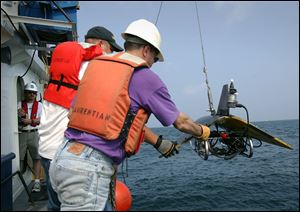
Newest Lake Erie 'dead zone' brings horror story for fish near Sandusky
7/19/2005
Andy Yehiela, left, and Nathan Hawley launch a Plankton Survey System from the Laurentian during a research operation on Lake Erie near Cleveland.
Allan Detrich / blade

Andy Yehiela, left, and Nathan Hawley launch a Plankton Survey System from the Laurentian during a research operation on Lake Erie near Cleveland.
CLEVELAND - Lake Erie's "dead zone" near here is expected to return in August, but scientists are more concerned about another such zone that is much closer to Toledo.
In a dead zone, there is so little oxygen along the lake bottom that fish cannot survive. Scientists have monitored the phenomenon in Lake Erie's central basin from Ashtabula to Cleveland for years, but 70 miles west, in the Sandusky sub-basin, the problem has worsened to the point that there is no oxygen at all.
"Anything lower than four parts of oxygen per thousand is problematic," said Stuart Ludsin, lead scientist on the Great Lakes Environmental Research Laboratory's Lake Erie project. "Around Sandusky, it's between zero and one parts per thousand in several spots."
To make matters worse, the dead zone arrived earlier than usual this year. Typically, oxygen levels are especially low in mid to late August; researchers discovered the low levels near Sandusky on June 29.
Recent tests indicate that there are about six parts oxygen per thousand in the lake's central basin.

Because the dead zone affects the bottom of the lake, the problem would not be noticeable to a boater. But fishermen would likely find fewer of the perch, walleye, and bass.
The oxygen level is a cause for concern in late summer because of the physical attributes of the lake, scientists said. The Sandusky sub-basin - near where Sandusky Bay empties into Lake Erie - is deeper than the western basin, which takes in oxygen when the wind creates water movement. But the sub-basin and the central basin are not as deep as the eastern basin, which naturally maintains a sizeable oxygen layer along the bottom.
Another part of the oxygen-depletion problem has to do with excess algae along the lake floor. Algae feed on phosphorus and other nutrients that enter the lake through falling rain or the runoff from rivers or sewage overflows, Mr. Ludsin said.
Still, researchers said they do not fully understand what causes oxygen depletion. That question is at the heart of a six-month, multimillion dollar study involving 35 scientists from several universities as well as the United States and Canadian governments.
"All our theories look very good on paper, but this is the first major study of its kind, so it's an opportunity to answer a lot of these questions," said Mike Quigley, a National Oceanic and Atmospheric Administration ecologist based in Ann Arbor.
Even more important than the causes of the dead zone, Mr. Ludsin said, are the effects it has on the ecosystem that surrounds Lake Erie. The researchers hypothesize that the lake's fish population will decrease, upsetting the food chain from the microscopic level up to the humans who eat fish from the lake.
During the day, many species of fish cluster in schools along the bottom of the lake, where temperatures are cool, predators few, and plankton abundant. If the oxygen level is too low, fish have to move toward the surface of the water or horizontally out of the dead zone, abandoning the habitat in which they thrive.
"Nobody has made a good link between the oxygen level and the fish population," Mr. Ludsin said. "The number of eggs depends on the size of the fish, and if they're out of their ideal conditions they may not grow as big."
To study the effects of the dead zone, engineers designed equipment capable of measuring the number and size of fish, the presence of the plankton that the predator fish feed upon, and the temperature of the water at different depths. NOAA engineer Steve Ruberg designed a "tow-yo," an electronic device towed by a boat that travels in wave patterns to quantify different factors.
"We can watch the measurements at the very bottom as well as closer to the top," he said.
When the study ends in October, Mr. Ludsin and his staff will report their findings to the departments of natural resources in Ohio, Michigan, and Canada. If their research indicates a clear link between low oxygen levels and decreased fish populations, they will focus on controlling the factors they can.
"Right now we have no way of controlling the oxygen levels," Mr. Ludsin said. "The only way to do anything is to figure out what causes it."
If scientists can't control what's causing the dead zones' creation, he offered one possibility that likely won't sit well with commercial, charter, or individual fishermen: "We may have to admit there will be fewer fish and cut back on harvest quotas."
Contact Megan Greenwell at:
mgreenwell@theblade.com
or 419-724-6050.